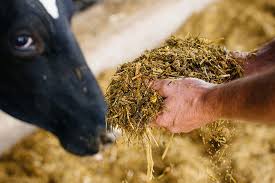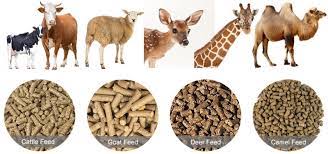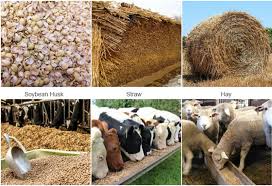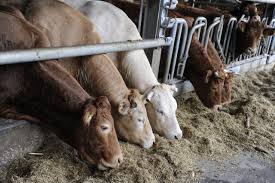This article discusses various types of feed materials available in the environment for the feeding of ruminant animals, as mentioned in the earlier article on the digestive ability of ruminants.
Adequate nutrition is crucial for the optimal growth and development of animals. While ruminants can survive on forage, it often lacks sufficient nutrients to meet the animals’ needs for growth and production. Therefore, their feed should be supplemented to ensure proper nutrition.
Read Also: How to Grow, Use and Care for Wiegand’s Sedge Grass (Carex wiegandii)
Definition of Certain Terms in Feeding And Nutrition

Certain terms are commonly used when discussing feeds and feeding materials for livestock:
1. Feed: A feed is a mixture of feedstuffs blended or processed in a form acceptable to livestock. It can also be described as any material that, after ingestion, is capable of being digested, absorbed, and utilized by the body for maintenance, growth, or production.
2. Nutrient: A nutrient is any food constituent or group of constituents with similar chemical composition that aids in the preservation and growth of the animal. Examples include proteins, carbohydrates, water, fats/oils, minerals, and vitamins.
3. Ration: This refers to a fixed amount of feed given or allocated to an animal on a 24-hour basis, or the total feed provided to an animal during a 24-hour period.
4. Diet: A diet is a combination of various ingredients in the correct proportions to meet the nutritional requirements of the animal.
Classification of Feedstuffs For Livestock Feeding

Feedstuffs are plant and animal tissues that contain the necessary nutrients for livestock. They are grouped into different classes based on their botany and chemical composition. These classes include:
1. Roughages: These feed materials are bulky in nature, with low weight per unit volume, and contain more than 18 percent crude fiber. They are low in energy and proteins but high in cell-wall material. Nutritionally, roughages can range from excellent nutrient sources (e.g., lush young grass, high-quality silage) to poor feeds (e.g., straw, hay, stover, chaff, browse).
2. Green (Fresh) Plants:
i. Pasture: Fresh pasture is a primary feed for ruminants.
ii. Silage: Fresh green grasses are cut and stored to be fed to animals.
iii. Crop Residues: These are plant materials that remain after harvest, such as leaves or stems.
3. Dry Plant Materials:
i. Hay: Grass or legumes harvested while young and dried.
ii. Straw: Mature plants, often dried before being cut.
iii. Crop By-products: Includes by-products from crops such as maize, groundnut shells, etc.
4. Concentrate Feeds: Concentrates are feed materials with low moisture and fiber content. They are rich in digestible nutrients. Concentrates are further classified into:
i. Protein Concentrates: These concentrates contain more than 20 percent crude protein. Examples of animal-origin protein concentrates include fish meal, blood meal, and milk powder. Plant-origin protein concentrates include groundnut cake, sunflower meal, and cotton seed meal.
ii. Energy Concentrates: These feedstuffs include cereal grains, roots, tubers, and fruits. They are rich in carbohydrates and provide high amounts of energy per unit weight, though they are generally low in protein. Examples include maize, sorghum, cassava, and yam.
Non-protein Nitrogen Compounds as Protein Sources
Non-protein nitrogen compounds are recognized as useful nitrogen sources for ruminants. These compounds depend on the rumen microbes’ ability to use them in the synthesis of microbial tissues. The most common non-protein nitrogen compounds include urea and poultry waste.
Mineral and Vitamin Supplements For Livestock Diets
Minerals and vitamins are often added to livestock diets as supplements. While minerals should be supplemented in ruminants’ diets, vitamins are typically not necessary since rumen microorganisms can synthesize most of them.
Mineral supplements can be obtained from animal bone meal, dicalcium phosphate, rock phosphate, eggshells, oyster shells, etc.
Read Also: How to Grow, Use and Care for Whitetop Sedge Grass (Rhynchospora colorata)
Common Feedstuffs For Livestock: Protein and Energy Sources

1. Protein Sources: Some common protein sources used in livestock feeding include:
i. Soybean Meal: A by-product of soybean oil extraction, it is widely used as a protein supplement with a crude protein value of 44-48 percent.
ii. Groundnut Cake: A major protein source, especially in northern Nigeria, with a crude protein value of 45-47 percent.
iii. Cottonseed Cake: A by-product of cotton oil extraction, it is relatively cheaper compared to soybean and groundnut cakes.
iv. Palm Kernel Cake (PKC): Contains about 20 percent protein and is a good protein supplement.
2. Energy Sources: Common carbohydrate-based energy sources include:
i. Maize: The primary source of energy for livestock, with the highest metabolizable energy (ME) of all cereal grains, 3442 ME Kcal/kg.
ii. Sorghum (Guinea Corn): Less palatable than maize, with lower metabolizable energy.
iii. Millet: Common in drier areas of the country where maize and sorghum do not grow.
iv. Wheat Offal: Residues from wheat milling, including wheat germ, bran, and other parts, which are rich in phosphorous and B vitamins but low in energy.
Other energy sources include cassava, molasses, rice bran, and various oilseed by-products.
This article has provided a comprehensive overview of the types of feed and materials available for ruminant animals, their nutritional value, and their classifications. Proper feed management and supplementation are critical to ensuring ruminants receive the right nutrients for optimal growth, reproduction, and production.
Do you have any questions, suggestions, or contributions? If so, please feel free to use the comment box below to share your thoughts. We also encourage you to kindly share this information with others who might benefit from it. Since we can’t reach everyone at once, we truly appreciate your help in spreading the word. Thank you so much for your support and for sharing!

